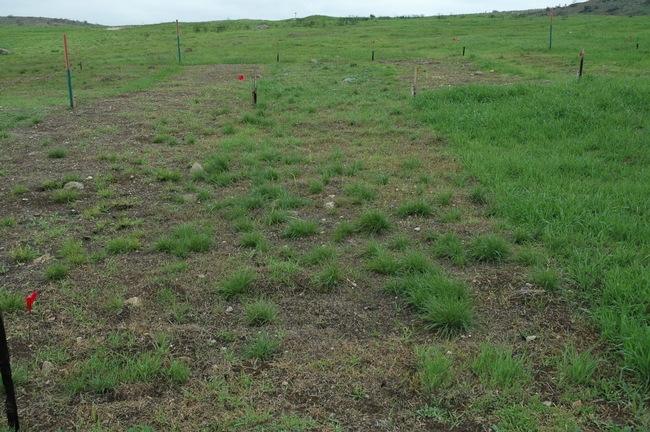From the Invasive Plants in Southern California blog :: April 11, 2014
A few years ago it became apparent from conversations and emails that the use of Fusilade (fluazifop-P-butyl, manufactured by Syngenta Crop Protection), a herbicide that only kills grasses (Poaceae), was increasing among wildland weed warriors. It's a very useful herbicide and can play an important role in natural habitat restoration.
But was this use consistent with the label? Was it legal?
Well, not really. There are two Fusilade products on the market, Fusilade II and Fusilade DX. The Fusilade II label says right on the top of the label that it is, “For the control of grass weeds in landscape areas, roadsides, nurseries, greenhouses, flower beds, groundcovers, interiorscapes, parks, sport fields, golf courses, commercial and residential sites.” No mention of wildlands, natural areas, open space, nada. Fusilade DX is the ag herbicide, labeled for use on crops, non-bearing crops and “listed” non-crop areas. The wording on the label says, “Agricultural noncrop areas include: around farm buildings and farm equipment storage yards and other agricultural noncropland areas.” Again, no mention of wildlands, natural areas, open space or anywhere else.
In legal terms, or I should say to be consistent with pesticide use laws and regulations in California, in order to use a pesticide on a site, that site has to be listed on the label. Site in this case means a habitat like crop (actually specific crops), ornamental landscape, forest, right of way, noncrop (which also needs some specificity like on the Fusilade DX label), wildlands, natural area, etc.

In another case I was asked about the use of Ronstar Flo, a preemergent herbicide (one that kills seedlings in the soil as they germinate) as part of a restoration project. Apparently, it had been used by someone, somewhere before and worked very well, so there was an interest in trying it on another site. Unfortunately, the title page of the label says, "For sale to, use and storage by commercial nursery, turf and landscape personnel only. Not for use on home lawns." So clearly this is another no-no.
The problem, in my opinion, is what looks like a loop-hole in the regulations. Once you are registered with the County Agricultural Commissioner as an entity that can buy pesticides from commercial distributors (e.g. you have an operator ID), you can buy whatever you want as long as it is not a restricted pesticide. So you can go to the local Target Specialty Products or Western Farm Service or Wilbur-Ellis or whatever and buy herbicides. You can buy what you want. But that doesn't mean that you can use whatever you want wherever you want to use it. The label has to allow that use on that site. And it is your responsibility to know that, it's not really a loop-hole and it's not the responsibility of the pesticide dealer. They are not required to ask you what you are going to do with the herbicide. So, bottom line, read the label before you purchase. If you are unsure ask someone like the sales people at the dealer, ask me or another UCCE advisor, or better yet, find a PCA (CA State licensed Pest Control Adviser) to write recommendations for you (let them take the responsibility, that's how the laws and regs are supposed to work).
I tend to get a little worked up over this issue, but I have reason to. Pesticides have had a negative public perception problem since the publication in the mid-70's of Rachel Carson's Silent Spring (essentially all of my 40 year career with herbicides as a key component). Using pesticides in CA is a privilege, like having a Driver's License; herbicides can be taken off the market, their use restricted or people can lose licenses if there are abuses in the judgment of CA-DPR. Essentially every event I attend that includes a discussion of herbicide use in wildlands is going to include someone that does not think that using a pesticide is a good idea. And these are people that are generally on our side with regard to controlling invasive plants in wildlands; they are our friends and sometimes very hard working weed warriors. But some are fully capable of making a fuss over the use of herbicides. So let's be careful, operating scrupulously within the laws and regulations is our best protection.